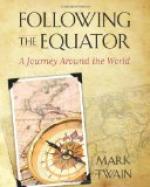In due course our ship entered the estuary called the Derwent, at whose head stands Hobart, the capital of Tasmania. The Derwent’s shores furnish scenery of an interesting sort. The historian Laurie, whose book, “The Story of Australasia,” is just out, invoices its features with considerable truth and intemperance: “The marvelous picturesqueness of every point of view, combined with the clear balmy atmosphere and the transparency of the ocean depths, must have delighted and deeply impressed” the early explorers. “If the rock-bound coasts, sullen, defiant, and lowering, seemed uninviting, these were occasionally broken into charmingly alluring coves floored with golden sand, clad with evergreen shrubbery, and adorned with every variety of indigenous wattle, she-oak, wild flower, and fern, from the delicately graceful ‘maiden-hair’ to the palm-like ‘old man’; while the majestic gum-tree, clean and smooth as the mast of ‘some tall admiral’ pierces the clear air to the height of 230 feet or more.”
It looked so to me. “Coasting along Tasman’s Peninsula, what a shock of pleasant wonder must have struck the early mariner on suddenly sighting Cape Pillar, with its cluster of black-ribbed basaltic columns rising to a height of 900 feet, the hydra head wreathed in a turban of fleecy cloud, the base lashed by jealous waves spouting angry fountains of foam.”
That is well enough, but I did not suppose those snags were 900 feet high. Still they were a very fine show. They stood boldly out by themselves, and made a fascinatingly odd spectacle. But there was nothing about their appearance to suggest the heads of a hydra. They looked like a row of lofty slabs with their upper ends tapered to the shape of a carving-knife point; in fact, the early voyager, ignorant of their great height, might have mistaken them for a rusty old rank of piles that had sagged this way and that out of the perpendicular.
The Peninsula is lofty, rocky, and densely clothed with scrub, or brush, or both. It is joined to the main by a low neck. At this junction was formerly a convict station called Port Arthur—a place hard to escape from. Behind it was the wilderness of scrub, in which a fugitive would soon starve; in front was the narrow neck, with a cordon of chained dogs across it, and a line of lanterns, and a fence of living guards, armed. We saw the place as we swept by—that is, we had a glimpse of what we were told was the entrance to Port Arthur. The glimpse was worth something, as a remembrancer, but that was all.
The voyage thence up the Derwent Frith displays a grand succession of fairy visions, in its entire length elsewhere unequaled. In gliding over the deep blue sea studded with lovely islets luxuriant to the water’s edge, one is at a loss which scene to choose for contemplation and to admire most. When the Huon and Bruni have been passed, there seems no possible chance of a rival; but suddenly Mount Wellington, massive and noble like his brother Etna, literally heaves in sight, sternly guarded on either hand by Mounts Nelson and Rumney; presently we arrive at Sullivan’s Cove—Hobart!




